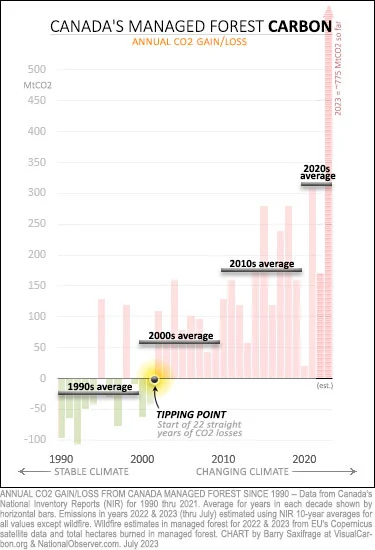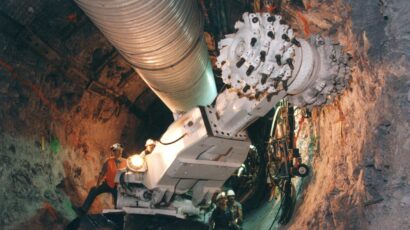Managed to death: How Canada turned its forests into a carbon bomb
By Barry Saxifrage | August 28, 2023
 Photo by Jamie Morris on Unsplash
Photo by Jamie Morris on Unsplash
Editor’s note: This story was originally published by Canada’s National Observer. It appears here as part of the Climate Desk collaboration.
This year’s coast-to-coast wildfires in Canada have already emitted an estimated one-and-a-half billion tonnes of CO2. That’s triple the annual climate pollution from burning fossil fuels in Canada. It’s more than the combined emissions from 100 nations. And there are still months of fire season looming ahead.
As extreme as this year’s wildfire emissions have been, they are just the latest escalation in a multi-decade flood of CO2 pouring out of Canada’s “managed” forests and forestry. (Note: Canada only reports emissions from the parts of the forest it “manages.” This is around two-thirds. Some managed forest areas are managed for logging, while others are managed for non-timber uses like recreation, water, wildlife and fire protection. See the endnotes for a map and more details.)
To illustrate the scale and pace of our metastasizing forest carbon crisis, I turned to data in Canada’s official national greenhouse gas inventory, plus recent wildfire data from the European Union’s Earth Observation Program. The resulting chart shows the cumulative amount of CO2 that’s been added to the atmosphere from Canada’s managed forest since 1990.

The falling green line at the start of the chart shows that in the early 1990s, the forest was a valuable carbon sink, helping to slow global warming. Back then, new forest growth absorbed more CO2 from the air than was emitted by logging, wildfire and decay.
That all changed after 2001, the tipping point year for Canada’s managed forest.
As the rising red line on the chart shows, since that year, the forest has emitted more CO2 than it has absorbed. A lot more. Logging, wildfires, insects and the many forms of decay are now turning trees into CO2 faster than the forest can grow back.
That pumped billions of tonnes of climate fuel into the atmosphere—even before accounting for this year’s epic wildfires (shown by the dashed line). With those included, the cumulative total since the tipping point year is now around 3,700 million tonnes of CO2 (MtCO2).
22 straight years of emissions. To appreciate just how dramatic the tipping point has been, take a look at this next chart. It uses the same data, but this time breaks it down into individual years.
Years when Canada’s managed forest removed CO2 from the air are shown in green. For example, that first green bar in 1990 shows the forest absorbed 100 MtCO2 more than it lost that year.
Red bars show the opposite.
Notice how every year since the tipping point has been a red year. That’s 22 straight years in which Canada’s managed forest lost carbon to the atmosphere. This clearly isn’t a problem caused by a few freak years. It’s an every-year crisis.
And this crisis is escalating. You can see how the decade averages are rising relentlessly (black horizontal bars).
Let’s look at what happened in the last decade. During the 2010s, forest carbon losses added an average of 175 MtCO2 per year to the atmosphere. That’s more than most nations emit, and yet Canada isn’t even counting it in our national total. The atmosphere, however, most certainly is. The more CO2 it gains, the more extreme the climate crisis becomes.
Any guesses on how many Canadian gasoline-burning cars we must take off the road to offset that much CO2? All of them. Plus all our heavy-duty freight trucks and every other form of fossil-fueled road transport. Oh, and we also must stop burning natural gas in every Canadian home.
Even that might not be enough. Because, as the chart shows, average emissions from our managed forest are running even higher so far in the current decade. The first time Canada’s forest carbon emissions exceeded 300 MtCO2 in a single year was in 2021. And this year’s emissions are already double that record.
There is this feel-good myth in Canada that our massive forest is offsetting some of our massive fossil fuel emissions. That might have been true decades ago under our old, stable climate. But we’ve so weakened our forest—through decades of business-as-usual industrial logging and fossil-fueled climate shifts—that it has switched to hemorrhaging CO2 instead of absorbing it.
Now we find ourselves in the opposite situation. Now, we must reduce our oversized fossil fuel emissions even faster, just to offset surging emissions from our managed forest and forestry.
If you’re like me, you’re probably starting to worry about how out-of-control this could get.
Tip of the iceberg. Canada’s forest is one of the largest terrestrial carbon storehouses on the planet. It contains billions of trees spread across hundreds of millions of hectares.
Just how much forest carbon are we talking about? One recent study by Natural Resources Canada estimates the above-ground biomass alone contains enough carbon to produce 60,000 MtCO2. A similar amount is currently held in roots and soil. In total, our nation’s forest easily holds 100,000 MtCO2 worth of carbon.

So, the roughly 3,700 MtCO2 lost to the atmosphere since 2001 is just the tip of our nation’s gigantic forest-carbon iceberg. There is more than enough carbon remaining to fill Canadian summers with raging megafires and toxic smoke for centuries to come. More than enough to overwhelm the climate pollution cuts we make elsewhere as we fight to get to net-zero greenhouse gas emissions.
Having a gigantic amount of forest carbon was a hugely valuable gift under our old, stable climate. It provided jobs, energy and materials that magically replenished themselves each year from thin air. As a bonus, all that forest carbon also helped cool the planet.
But decades of business-as-usual logging and fossil-fuel burning have transformed this valuable gift into a growing threat. Canada’s managed forest is looking less and less like a carbon bank—and more and more like a carbon bomb.
Defusing this gigantic carbon bomb will require addressing the two main drivers of forest carbon losses—industrial logging and fossil fuel burning.
Logging more than grows back. For the last two decades, industrial logging has been extracting far more carbon from Canada’s managed forest than has grown back. That’s added billions of tonnes of CO2 to the atmosphere.
My next chart shows the details.
Canada reports managed forest CO2 in two parts—from in the forest and from the wood hauled out of it.

The first part is shown by the green bars. This is the net balance of CO2 removed from the air by new growth minus CO2 emitted by fire and decay. You can see how dramatically this balance has flipped from absorbing CO2 to emitting it.
The second part is the CO2 emitted by wood hauled out of the forest. This is known as “harvested wood products” and is shown by the brown bars. Notice how harvested wood levels have remained very high—at around 135 MtCO2 per year—even as forest growth has totally collapsed.
You can see how back in the 1990s, logging extracted about the same amount (brown) as the forest grew back (green). Maybe that could be considered carbon-neutral, depending on the conditions.
But during the 2000s, logging extracted twice as much carbon as grew back. And since then, we’ve been logging a forest that isn’t growing back at all. That isn’t carbon-neutral. It’s climate crazy.
For those of us hoping to prevent a full-blown climate breakdown, the obvious question is: How much of the CO2 pouring out of our forest is caused by logging? Or put another way: Can we reduce the climate threat by logging less?
How much CO2 is caused by logging? It’s been 35 years since Canada first promised to cut emissions (spoiler alert: we haven’t). By now, you’d think our government would at least report how much CO2 a huge industry like logging adds to the atmosphere. But it doesn’t.
The government has the data—but they mix critical logging emissions data in with other forest emissions. For example, I asked Environment Canada for something as basic as the emissions from all dead biomass that logging leaves behind in the forest each year (often referred to as “slash”). The department said they track it but declined to provide the number.
Environmental groups have been trying for several years, with little success, to persuade the government to accurately and transparently report logging emissions. Recently, the Natural Resources Defense Council (NRDC) and Nature Canada published their own estimates using the limited government data available.
In their report, “What are the net greenhouse gas emissions from logging in Canada?”, they calculate an average over the last decade of 86 MtCO2 per year. As my next chart shows, this rivals the emissions from heavy industry and buildings. Unlike other sectors, however, Canada exempts this logging industry CO2 from emission pricing or climate targets.
As this chart also shows, the total emissions from our managed forest averaged 175 MtCO2 per year during the last decade. That rivals our two worst sectors—transportation and the oil and gas industry. The additional forest CO2 beyond what is caused by logging has primarily been caused by fossil-fuelled climate changes.
So let’s look at that next.
Fossil-fuelled death and decay. Fossil fuel burning is rapidly overheating and destabilizing our climate.
Canada’s forest is especially vulnerable because temperatures are rising here two to three times faster than the global rate. That’s driving rapid changes in wildfires, lightning, drought, snow cover, stream flows, water temperatures, insect outbreaks, disease, melting permafrost and a Pandora’s box of other environmental shifts.
Trees don’t get to move when fossil fuel pollution turns their climate hostile. Instead, they weaken, grow less and fall prey to turbocharged outbreaks of insects, fungi and disease. More trees die. And many more burn as fossil-fueled heat and droughts unleash extreme megafires.
Natural Resources Canada is blunt about the threat in its State of Canada’s Forests 2020 report: “Scientists predict that increasing temperatures and changes in weather patterns associated with climate change will drastically affect Canada’s forests in the near future. With the rate of projected climate change expected to be 10 to 100 times faster than the ability of forests to adapt naturally.”
These climate impacts will grow ever more extreme until we stop burning fossil fuels.
Despite decades of promises, that’s something we haven’t even started to do in Canada.
You can see how Canada’s doing compared to our peers in the Group of Seven (G7) in this next chart. Collectively, these wealthy, industrialized nations emit one-third of global climate pollution and produce half the world’s GDP. If we are going to have any shot at preventing a full-blown climate crisis, this group with much of the world’s financial resources, capabilities and talent must lead the way.
As you can see, all of our G7 peers emit less than they did in 1990. And, importantly, all of them were reducing emissions in the years before the pandemic crash (dotted lines on chart).
Not Canada. We are the only one still polluting far more than when we started promising to cut emissions more than three decades ago. And we were the only G7 nation still increasing our emissions before the pandemic hit.
We know it is possible for advanced economies to slash emissions. Just look at our Commonwealth peers, the British. They have the world’s sixth-largest economy—one and half times the size of Canada’s. They’ve cut their climate-destabilizing emissions in half. We know what works, we just aren’t acting.
Canada’s forest is in trouble. And so are we. The dangerous reality is that we’ve knocked our forest off balance with unrelenting fossil fuel burning and chainsaws. It’s now struggling and losing wood at an increasing pace. Forest growth has collapsed past the tipping point, while our logging continues at old-climate levels.
Unlike some ecosystems we’ve destabilized, however, our forest isn’t going quietly. It bleeds climate-destabilizing CO2 by the megatonne. And much of it chokes our cities in apocalyptic shrouds of toxic smoke.
We might be ignoring this rising flood of CO2, but the climate isn’t. It doesn’t care about our pencil-pushing tricks and excuses. It just reacts blindly to the amount of CO2 piling up in it.
My final chart shows the rapidly growing difference between the climate pollution that Canada officially reports (black line) and the amount actually going into the atmosphere (light red line)
That doesn’t look to me like we are cutting off the flow of climate fuel and heading toward climate safety. It looks like we are in deep trouble.
Canada’s managed forest is a gigantic carbon bomb. Decades of surging emissions from it are a flashing red light, warning that we are at risk of it running away from our control.
Is that the dystopian legacy we want to leave for countless generations of Canadians that follow us? If not, we need to start taking the threat seriously and act to defuse it while we still can.

Together, we make the world safer.
The Bulletin elevates expert voices above the noise. But as an independent nonprofit organization, our operations depend on the support of readers like you. Help us continue to deliver quality journalism that holds leaders accountable. Your support of our work at any level is important. In return, we promise our coverage will be understandable, influential, vigilant, solution-oriented, and fair-minded. Together we can make a difference.
Keywords: Canada, Carbon emissions, carbon sink, deforestation, forestry, forests, greenhouse gases, logging, tipping point, tipping points, wildfires
Topics: Climate Change















Today we in BC are having a incredible lightening storm. I’ve never seen it likes this and its to continue for days. sounds like bombs going off. The main reason we have so many fires in Canada now is that the land is much much drier than it was 20 years ago. The heat and draught has dried out all the trees, grasses, and the soil which makes them tinder dry. Before when lightening hit the fires would mostly die out as its too wet. Now it creates a mega blaze that can jump huge lakes. Add the strong wind… Read more »
So what would be a couple of realistic solutions to the problem? What would the top ten actions be along with their cost and impact on people and the levels of carbon in the atmosphere? There is a serious debate needed on best actions to reduce atmospheric carbon vs. react and adapt to it.
Canada’s GHG emissions constituted less that 1.5% of global, as a country, in 2020, where countries like China soars at 28%. I don’t think that anything would change if Canada alone drops to zero by 2029, when China’s committed to start reducing is only after 2065 and accomplished by 2080 at best. Plainly put, there’s no commitment whatsoever by the real emitters. Canada needs a Ministry of Forestry focused specifically on the problem and rehire forest management servants to pre 1990 levels. We can’t stop rotting but we can mitigate fires better.